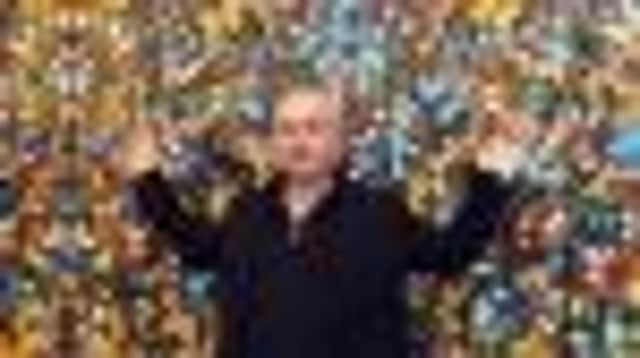Look back in aspic... Starstruck life of Damien Hirst


while his personal art collection was being sold for a record £111m, Damien Hirst was firstly playing snooker with Ronnie O’Sullivan and then later went to Claridge’s where he drank tea with Ronnie Wood in a suite.
We know this because Wood was one of the talking heads lined up to pour forth on how brilliant his friend Hirst is in a Channel 4 programme made about the artist ahead of his first ever retrospective at the Tate, which opened this week.
Advertisement
Hide AdAdvertisement
Hide AdLed by Noel Fielding, Hirst granted the first ever personal tour of some of his artworks for the Channel 4 broadcast. The banality of comedian Fielding proclaiming at being introduced to every new piece of art by Hirst ‘I love this, it’s really good’ was interspersed with the great and the good talking about how great an artist Hirst is.
Keith Allen and his daughter Lily, Bono, Ronnie O’Sullivan, Joan Collins, they were all lining up to praise the Leeds-born and raised artist.
According to Wood, as the now legendary Sotheby’s auction of his work took place, in the suite at Claridge’s Hirst would occasionally look at his computer (his ‘people’ were keeping track of the auction for him) and check on the money rolling in.
The £111m raised over those two days shattered the previous record for a single artist’s sale - Picasso’s 88 works sold for £11m in 1993.
Advertisement
Hide AdAdvertisement
Hide AdIt was, said fellow artists, one of the most audacious moves an artist had ever pulled off. But according to those with financial nouse, it was much more than just audacious.
It was a stroke of luck and timing that Hirst would have been a fool to dream of. Stick it in a plot and it would be decried as Shakespeare would have it as ‘an improbable fiction’.
The Hirst record destroying sale came on the eve of the global financial collapse. The day following the sale Lehman Brothers went bankrupt, and the global financial crisis really hit its straps.
That the richest artist on earth made the biggest art sale in history 24 hours before the world was plunged into financial turmoil is actually a seemingly appropriate signpost on Damien Hirst’s extraordinary journey.
Advertisement
Hide AdAdvertisement
Hide AdTwo books which investigate the phenomenon of the richest living artist, who couldn’t sell a piece at a famous exhibition he himself organised, have been re-issued this week to coincide with the Tate’s Hirst retrospective.
The $12Million Stuffed Shark: The Curious Economics of Contemporary Art by Don Thompson and Lucky Kunst: The Rise and Fall of Young British Art by Gregor Muir, both published by Aurum, provide an insight into the bizarre steps that led Hirst from Leeds Art College to billionaire status.
Interestingly, read together, the books tell a complete story. Gregor Muir, now executive director of the ICA tells the early story of how Young British Art was born and what it was like to be at the beginning of the movement in Shoreditch, London - as he was.
In The $12Million Stuffed Shark, Don Thompson asks the question: “Why would a smart New York investment banker pay twelve million dollars for the decaying, stuffed carcass of a shark?”
Advertisement
Hide AdAdvertisement
Hide AdEconomist Thompson, who teaches at LSE and Harvard, explains what alchemy Hirst used to turn decaying flash into pure gold - and how we all bought into it along the way.
The Damien Hirst retrospective runs at Tate Modern until September 9.
• Born in 1965, Damien Hirst grew up in Leeds.
• After school, which he famously left with “an E in Art A Level” he attended Leeds College of Art and then Goldsmiths College.
• In 1988 he staged Freeze, a student art show in a disused Warehouse - which became the recognised birthplace of the Young British Artist.
Advertisement
Hide AdAdvertisement
Hide Ad• In 1991 he had his first solo show, a year later he was nominated for the Turner Prize and in 1995, he won it. In 1992 he displayed “The Physical Impossibility of Death in the Mind of Someone Living,” a • 14-foot-long glass tank with a shark preserved in aspic.